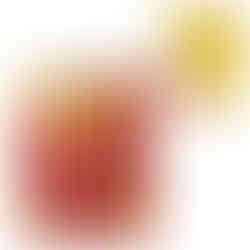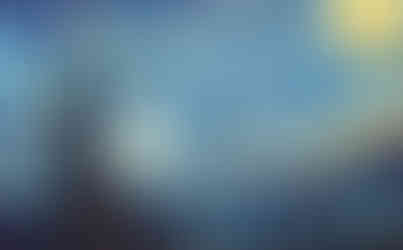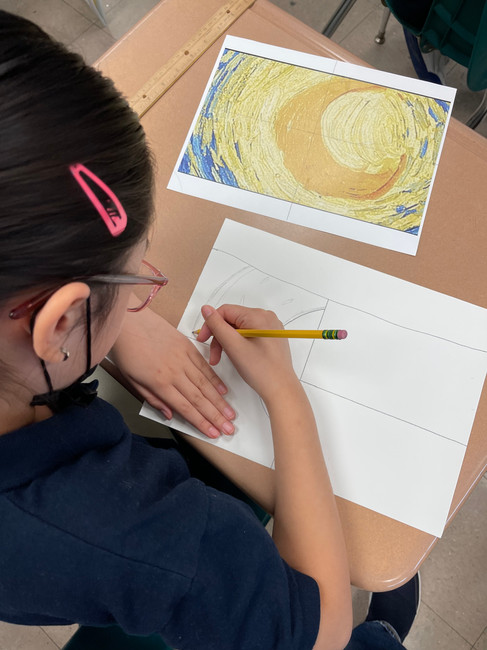Changing views/values/priorities
- frida@artyardbklyn.org

- Apr 1, 2022
- 8 min read
Updated: Apr 7, 2022
This week ART YARD Advanced Studio on Zoom approached our theme Restore and Heal with Karla Prickett in her provocatively titled session Composition and Use of the Color White: Our Environments. A response to introspections – changing views/values/priorities during isolation or devastation. Solace, observation, statement.
Karla’s own piece which she started in advance to show as a sample, then completed during and after the session Composition and White is a collage on handmade paper, cut paper and white ink.

Karla summarizes: “Quite likely, some of us, myself included, were unfamiliar with the work of the two artists I selected as the main inspiration for the lesson. After reading Marian Wardle’s American Women Modernists, I was quite taken by the white line lithography of Ada Gilmore and immediately drawn to the architectural postage stamps of Emilio Sanchez. The color white seemed key to the success of their compositions even though their imagery was quite different.”


Vera, Nayarit and Ed all addressed the horror of bombings in Ukraine and those directly suffering.



Marilyn used white pencil on black paper in her drawing about immigration.

Zeke and I worked in a similar palette inspired by the architectural forms and color of Emilio Sanchez.


Delphine narrowed her color use to black, white and red in a symbolic personification of blood.
Delphine Levenson, Blood Yells and Blood Cries
Maraya created a video titled Op. BlaBlaBla and describes her inspiration: “For this piece, I was inspired by game paintings that are stored in my studio, remnants of the past. Playing with the video app on my phone, I transformed them into a video sound composition. Sound is juxtaposed with image, with an emphasis on white.”
Karla relays “compliments to all for creating such moving visual narratives! Each artist drew upon personal reactions to past or present - expressing something experienced, felt or witnessed. Using white as negative space, outline, defined object, background or elements of movement, the outcomes were successful and meaningful. Subject matter included: an eerie scene of immigrants waiting for a train, a pandemic home landscape, the horrors of bombings in Ukraine, a studio space of contemplation, a place of prior travel, digital imagery responding to moving, and a personification of blood – “blood seeks attention.” The challenge of using white in composition was met through watercolor, ink, cut paper, and digital layering. Thanks to all for sharing your thoughts and visual responses! I enjoyed leading my first lesson!!!”
ART YARD Advanced Studio in person at BWAC upped the ante on our erudite artistic exploration as we embarked on the first of a month-long series with Teaching Artist Ed Rath. (I was so rapt by the discussion at the end of class that I forgot to take photos of the individual drawings. Whoops!)
Class began with a discussion around the question, “What is the Picture Plane?” Some definitions of Picture Planes include:
A Frame through which we “Picture” the world;
A Frame which formalizes our field of vision;
A Matrix upon which we apply marks to indicate space, form, and ideas;
A Two Dimensional Representation of Three Dimensional Space.
Examples of Picture Planes include:
A blank canvas;
A movie theater screen;
A photograph;
A slide;
A computer Screen;
A grid, complete with axis lines and points indication spatial locations;
An image on the lens of a microscope or telescope.
An image pictured, imagined, or visualized in your mind’s eye.
Next, we talked about different ways to break the picture line with drawing. We went for a short walk through the BWAC gallery rooms and observed how the horizon line in our viewing windows moved up and down as we moved our heads, and how the wood columns moved toward the outside edges and beyond of our viewing windows as we walked closer to them. It was noted that this dynamic movement occurs in the 3 dimensional world but not in the 2-dimensional world of the picture plane, where everything is frozen.

Ed explains: “We observed that on the picture plane, objects are depicted as flat shapes delineated by contour lines, and the negative shapes are also represented by flat shapes. This contrasts with the 3-D world, where objects are solid forms but the negative space around them is not solid. How to resolve this conundrum has puzzled artists since the first artists drew on cave walls. Every generation of artists since has found new ways to address the question of how to depict the three dimensional world within the limits of the Picture Plane.
For inspiration we looked at Cezanne’s landscapes of the south of France. Cezanne utilized multiple points of view to create a sense of movement through his compositions. It was noted that symmetrical compositions create static images, whereas asymmetrical compositions create dynamic images.


Next, we began our drawings. Our goal was to depict a Landscape or Interior space using a horizon line and perspective points to define the Point of View from which the scene originates.
Evelyn produced a beautiful illusionistic landscape of a lake in Maine, with deep space indicated by trees drawn in perspective; Nayarit’s landscape included a winding road, coming from the right edge of the picture, getting narrower as it approached the horizon lime; Vera’s picture depicted an unusual point of view of a landscape seen from above; Ijenna’s piece include three clearly delineated spaces – the foreground, at the bottom of the page, the middle ground, across the center section, and a far off background, located at the top of her composition.
Meridith drew a complex image viewed through the window which included a horizon line in the far distance, several buildings and objects in the foreground and middle ground, and some reflected images on the window pane.
Robin also made a tightly organized composition of the view outside the window, along with a second drawing depicting the interior of the BWAC gallery space showing, The Planes in Motion as she walked through the space.

Next week we will develop the line drawings we did this week, adding watercolor to create Local Color.”
Robin wrote later in the week: “I really appreciated Ed’s drawing class! It made me view painters like Hooper and Cézanne differently! I was inspired to do a live drawing on canvas for a painting at a local cafe!”

Teaching Artist Evelyn Beliveau writes: “We had a good lesson at ART YARD Art Matters at BNS this week! Students worked diligently and made progress on their Surrealist-inspired collages.

Last week, students had made drawings on pieces of paper shaped like the iris of an eye, with the content of the drawings inspired by their hopes and plans for springtime. This Tuesday, students collaged their drawings onto toned brown paper and began to draw the shape of the eye around the iris using black and white pencils.
We provided examples and a diagram of parts of the eye--tear duct, eyelid, lower lid, eyelashes, etc.--to guide students in structuring their drawings. For shading, we talked about the three-dimensional, spherical nature of the eye and directed students to use the white pencils to highlight areas that come forward and catch the light (like the front of the eyeball and the top of the upper lid) and black pencils to shade parts that are in shadow (the corner of the eye) or dark in color (such as eyelashes). Students looked at each others' eyes to confirm their shading choices.

During critique, students noticed color use and the inclusion of abstract shapes or more representational/descriptive elements in the imaginative portion of their peers' artworks. We also discussed how combining realistic and impossible elements leads to a "surreal" artwork--MORE than reality!”

At ART YARD Art Matters at PS6 we began a new cycle of classes. Managing Director Dennis Buonagura and Teaching Artist Evelyn Beliveau have to arrive early and work hard all day with this energetic, engaged and academically rigorous Jersey City elementary school, and we LOVE it! Dennis enthusiastically reports frequent principal and assistant principal sightings in our classes and classroom teachers are true collaborators, who engage with their students in such a way that lessons are always exciting.
Evelyn summarizes: “We started a new cycle at PS 6 this week. During this project, each class will engage with a painting from art history and learn the gridding technique to collaboratively recreate the image. With our three classes, we introduced images and a bit of background info on the painters Vincent van Gogh, Stuart Davis, and Georgia O'Keeffe, respectively.

Each piece was chosen for its connection to the restorative properties of art or art making--for example, Vincent van Gogh found solace in art making, and Georgia O'Keeffe intended for her paintings of flowers to get viewers to slow down in their busy lives and take a moment to reflect. Stuart Davis's abstract compositions synthesize visual elements to preserve a sense of the exhilaration he felt while looking at the scene or objects that were the starting point of each painting.
Students responded enthusiastically to the images. Students likened O'Keeffe's work "Red Canna" to the human heart or muscles as well as floral imagery. Stuart Davis's piece was compared to a collage or puzzle, and even to a student's messy room. Students commented on the deep blues and natural scenery in van Gogh's "The Starry Night."

In each class, we gave each student a printout of 1/25th of the painting. We showed them the big grid and how their individual pieces fit together to create the whole image. Then, each student made another grid on their printouts, dividing the page into quarters by folding or measuring with rulers. They created a matching grid on their blank sheets of paper, learning some valuable ruler skills along the way!
Next, students drew pencil outlines, interpreting the contours of the original image. Working one box at a time, they used the grid lines to help place the contours exactly where they wanted them.
In the coming sessions, we will add color and then put the pieces together to see our classes' recreations of these classic paintings come to life!”
Following on the heels of a visit to the Brooklyn Museum to view The Slipstream: Reflection, Resilience, and Resistance in the Art of Our Time a fantastic exhibition which draws examples from the museums contemporary art collection to contemplate the profound disruption that occurred in 2020, Wagner College students participating in my class Making & Seeing Art in NY wrote essays about causes that are personally relevant and important to them. This week ART YARD Teaching Artist Vera Tineo joined us in our studio at Wagner to lead a session inspired by the work of William Kentridge.

After viewing two short videos of Kentridge in the studio discussing his work Vera shared a detailed PowerPoint explaining our process. We prepared the studio carefully and donned gloves knowing that the materials – several types of vine charcoal and erasers – could get messy.

In 5-10 minute intervals, students depicted their important topic, responding to Vera’s prompts, repeatedly taking photos as their drawings morphed.
These images will become animations. Next week we will incorporate spoken audio and sound.








Other Art News:
If you are in NYC, a must see exhibition is Dakota Modern: The Art of Oscar Howe on view through September 11, 2022 at the National Museum of the American Indian, One Bowling Green, in lower Manhattan. The museum is open Monday – Friday, 10am-5pm and is free to the public.

From the press release: “Howe (1915–1983) committed his artistic career to the preservation, relevance, and ongoing expression of his Yanktonai Dakota culture. He proved that art could be simultaneously modern and embedded in customary Očhéthi Šakówiŋ (Sioux) culture and aesthetics—to him there was no contradiction.
Howe challenged the art establishment’s preconceptions and definitions of Native American painting. In doing so, he catalyzed a movement among Native artists to express their individuality rather than conforming to an established style. This legacy of innovation and advocacy continues to inspire generations of Native artists to take pride in their heritage and resist stereotypes.

TOMORROW Saturday, April 2, 7-8:30pm grab your sketchbooks and drawing supplies, then head on over to FiveMyles (558 St. Johns, Crown Heights, Brooklyn) to participate in Observation/Transformation, a lively evening of life drawing and spontaneous tableaux vivants with improvised movement organized by Edward Monovich, with music and guest performers.

Hope to see you and your sketchbook tomorrow at FiveMyles!



















































Comments